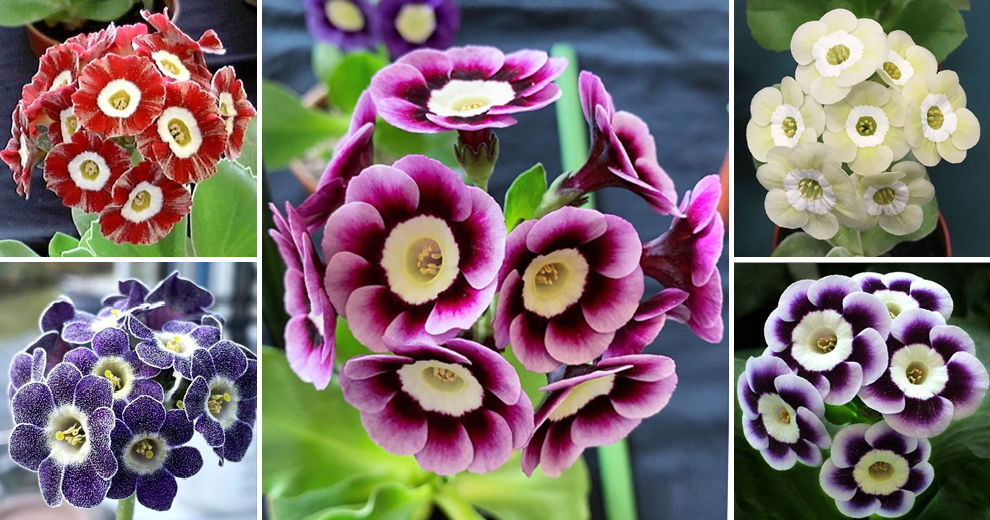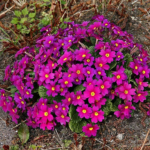Primulas are easy-to-grow perennials that come in many colors and shapes. Many people when they think of Primula will think of the popular Polyanthus types illustrated to the left and they make a happy display. But there are many more Primulas in all shapes, sizes and colors of Primula that bloom in spring to early summer.
Within the genus, the Polyanthus group (pictured left) is the most common, often sold online and in garden centers as a winter and spring bed. Just a note about these Polyanthus, they are hardy and you can pick them up from the garden center in February and March and plant them out. They are H5 hardy, which is usually hardy across the UK (except in extreme weather.)
Where to plant Primula
White candelabra primrose
Primula likes to grow in moist soil, and many varieties including candelabra are popular for growing by streams, in bog gardens and are also tolerant of partial shade.
Primroses are bright and cheerful and perfect for a spring border. Primroses are best planted in dappled shade in soil that is moist and not prone to drying out. If you have a wet area with partial shade, Primulas are perfect. Candelabra varieties will grow in even wetter conditions, including a bog garden
Primula is a woodland plant that enjoys a position in partial shade and benefits from a compost of organic matter or leaf mould. Primula are tough plants and do well in most places as long as it is not too dry or baking hot sun. Sometimes the leaves of Primula can get a little discolored, brown around the edges and removing these won’t hurt, (provided it’s just a few and not too many as the plant needs leaves for photosynthesis) and even dead mulching helps to keep the plant blooms.
The simple primrose, Primula veris pictured bottom left, looks beautiful in a natural setting and will colonize a bank and form clumps. It is a more delicate, simpler version of the primrose cousins in the Primula family. Primula self-seeds close to the mother plant, and it is easy to dig up the small plant and grow on or discard as needed.
Primulas look good planted in mass together, and with spring flowering bulbs. The later flowering varieties such as candelabra are ideal with Geraniums and Geums as shown in the photos below on the right.
More ideas about spring flowers and also spring blooming combinations.
Different types of Primula
In the first picture, top left, is the Primrose group which includes Primula vulgaris, the common early blooming primrose.
Picture center is of the candelabra varieties, P. beesiana which is a taller, later flowering Primula.
Illustrated top right is P. denticulata which, as the name suggests, looks like a ‘drum stick’. It is early flowering and a popular Primula to mix with spring bulbs.
P. candelabra are deciduous which means they die back in winter, but they reliably return each year for a stunning spring display and often bloom into early summer. The polyanthus and primrose groups tend to be evergreen or semi-evergreen.
Primula vulgaris, the common primrose looks beautiful in a natural setting such as on a beach edge, and it will multiply over time. Some varieties of Primula vulgaris are fragrant and shade tolerant. While many Primroses are low growing the popular Candelabra beesiana will grow up to 60cm and the variety ‘Harlow Carr’ pictured below left is tall and has mixed tones of oranges and pinks
The name Polyanthus describes hybrids of P. vulgaris (Primrose) and P. veris (Cowslip) and these plants are often treated as litter and discarded each year. In fact, they are perennial and come back next year, especially if planted in favorable conditions. To keep them going for a few years, Polyanthus are best planted where there is good winter and spring light, because that’s when they grow and flower. Polyanthus have some shade over the summer as they die back and then hopefully start again in the winter. Although Polyanthus are perennials and so can potentially live for many years, in reality most gardeners will persuade them to flower for only 3/4/5 years, after which they can look a bit tired and have few flowers. The name Primula comes from the Latin primis, meaning first and often Polyanthus is one of the first and most welcome flowers of spring.
 Flower Love
Flower Love


















